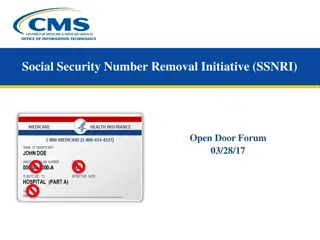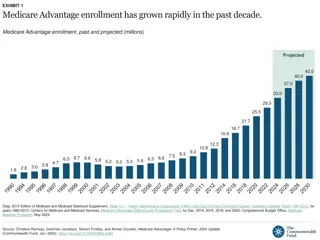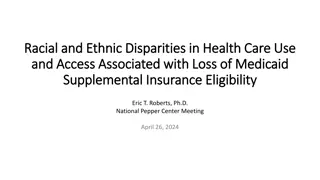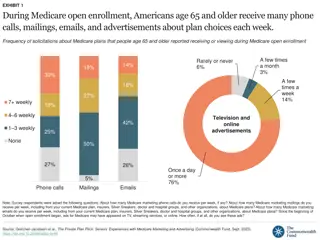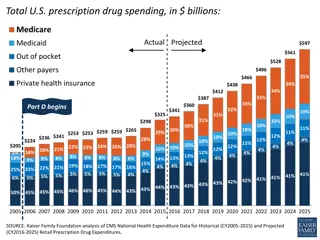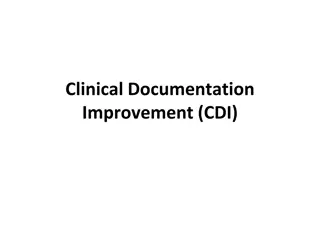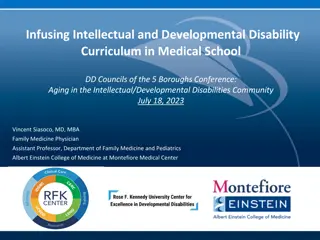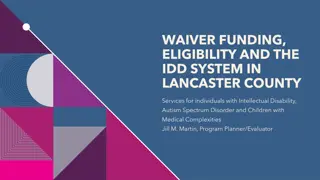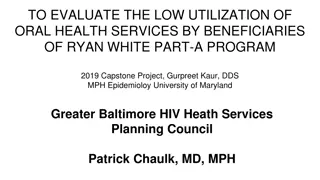Characteristics of Medicare Beneficiaries with IDD: Analysis Summary
This analysis delves into the demographics, chronic conditions, and prevalence of Intellectual and Developmental Disability (IDD) among Medicare fee-for-service beneficiaries. The study aims to understand the IDD population and disparities in healthcare access and quality, providing insights by state. Using data from CMS, the study focuses on categories like Autism Spectrum Disorders, Cerebral Palsy, and Learning Disabilities among the IDD population.
Download Presentation

Please find below an Image/Link to download the presentation.
The content on the website is provided AS IS for your information and personal use only. It may not be sold, licensed, or shared on other websites without obtaining consent from the author. Download presentation by click this link. If you encounter any issues during the download, it is possible that the publisher has removed the file from their server.
E N D
Presentation Transcript
Characteristics of Medicare Beneficiaries with Intellectual and Developmental Disability Elsa Haile Elsa.Haile@CMS.HHS.GOV Office of Minority Health Centers for Medicare & Medicaid Services February 13, 2019
CMS OMH Mission & Vision Mission To ensure that the voices and the needs of the populations we represent are present as the Agency is developing, implementing, and evaluating its programs and policies. Vision All CMS beneficiaries have achieved their highest level of health, and disparities in health care quality and access have been eliminated.
Purpose of Analysis To have a better understanding of Medicare beneficiaries with intellectual and developmental disability (IDD) Focus on Medicare fee-for-service beneficiaries Determine prevalence of IDD Describe demographics of the IDD population Determine prevalence of some chronic conditions and mental health conditions of the IDD population Determine prevalence of the IDD population by state
Data Source & Inclusion/Exclusion Centers for Medicare & Medicaid Services (CMS) Chronic Conditions Data Warehouse (CCW) Master Beneficiary Summary File (MBSF) Chronic Conditions data file Other Chronic or Potentially Disabling Conditions Inclusion CY2016 data Only Medicare Fee-For-Service beneficiaries with Part A and Part B for all 12 months of the year Exclusion Any Medicare Advantage beneficiaries
Categories of IDD Related Conditions Autism Spectrum Disorders Cerebral Palsy Intellectual Disabilities and Related Conditions Learning Disabilities Other Developmental Delays
Study Population Study Population Number Percent Total Medicare Population 59,818,481 Total Medicare Fee-For-Service Population 40,131,362 67.09% Final Sample Size (Parts A & B benefits all year) 30,987,261 Original Reason for Entitlement (OREC) 23,230,077 Old age and survivor s insurance 74.97% Disability or Disability with End Stage Renal Disease 7,648,396 24.68% End Stage Renal Disease Only 108,788 0.35% Intellectual Developmental Disability (IDD) Related Conditions* 483,595 1.56% Autism Spectrum Disorders 69,844 0.23% Cerebral Palsy 109,320 0.35% Intellectual Disabilities and Related Conditions 338,005 1.09% Learning Disabilities 51,551 0.17% Other Developmental Delays 41,025 0.13%
Number / Percent of Beneficiaries with Multiple Conditions Multiple Conditions* Frequency Percent 1 377,122 77.98% 2 89,353 18.48% 3 14,719 3.04% 4 2,245 0.05% 5 156 0.03% Total 483,595 100% *If a beneficiary has been diagnosed with autism, cerebral palsy, intellectual development, learning disability, and/or other development delay. Note - The percent's do not sum up to the total because of rounding.
Distribution of Medicare Beneficiaries with IDD Related Conditions by Age Group, CY2016 92.4% Autism Spectrum Disorders 5.9% 1.7% 79.5% Cerebral Palsy 14.5% 6.1% 80.7% Intellectual Disabilities and Related Conditions 13.7% 5.6% 50.6% Learning Disabilities 19.7% 29.7% 79.6% Other Developmental Delays 14.2% 6.2% 77.7% Total* 14.0% 8.3% 0.3% Beneficiaries with no Disabilities** 55.3% 44.5% 0% 10% 20% 30% 40% 50% 60% 70% 80% 90% 100% <65 65-74 75+ * If a beneficiary has been diagnosed with autism, cerebral palsy, intellectual development, learning disability, or other development delay. ** Beneficiaries were excluded if they were eligible to Medicare because of a disability and / or had any potentially disabling conditions.
Distribution of Medicare Beneficiaries with IDD Related Conditions by Age Group, CY2016 35% 33.2% 30% 25% 20% 18.0% 15.8% 14.0% 15% 10.3% 10% 8.3% 5% 0% <30 30-39 40-49 50-64 65-74 75+ Age Group Note: A beneficiary with IDD related conditions has been diagnosed with autism, cerebral palsy, intellectual development, learning disability, or other development delay.
Distribution of Medicare Beneficiaries with IDD Related Conditions by Sex, CY2016 26.3% Autism Spectrum Disorders 73.7% 47.6% Cerebral Palsy 52.4% 44.2% Intellectual Disabilities and Related Conditions 55.8% 50.0% Learning Disabilities 50.0% 45.3% Other Developmental Delays 54.7% 43.9% Total* 56.1% 55.8% Beneficiaries with no Disabilities** 44.2% 0% 10% 20% Female 30% 40% 50% 60% 70% 80% Male *If a beneficiary has been diagnosed with autism, cerebral palsy, intellectual development, learning disability, or other development delay. ** Beneficiaries were excluded if they were eligible to Medicare because of a disability and / or had any potentially disabling conditions.
Distribution of Medicare Beneficiaries with IDD Related Conditions by Race and Ethnicity, CY2016 0.8% 1.4% Total* 6.6% 14.0% 75.9% 0.4% 3.0% Beneficiaries with no Disabilities** 5.2% 6.6% 82.4% 0% 10% 20% 30% 40% 50% Hispanic 60% Black 70% White 80% 90% American Indian and Alaska Native Asian and Pacific Islander * If a beneficiary has been diagnosed with autism, cerebral palsy, intellectual development, learning disability, or other development delay. ** Beneficiaries were excluded if they were eligible to Medicare because of a disability and / or had any potentially disabling conditions.
Distribution of Medicare Beneficiaries with IDD Related Conditions by Dual Status, CY2016 81.4% Autism Spectrum Disorders 5.2% 13.4% 79.1% Cerebral Palsy 4.4% 16.5% 85.3% Intellectual Disabilities and Related Conditions 4.6% 10.1% 52.8% Learning Disabilities 7.2% 40.0% 80.7% Other Developmental Delays 6.3% 13.1% 78.4% Total* 5.1% 16.6% 4.7% Beneficiaries with no Disabilities** 0.9% 94.5% 0% 10% 20% 30% 40% 50% 60% 70% 80% 90% 100% Full Dual Status Partial Dual Status No Dual Status * If a beneficiary has been diagnosed with autism, cerebral palsy, intellectual development, learning disability, or other development delay. ** Beneficiaries were excluded if they were eligible to Medicare because of a disability and / or had any potentially disabling conditions.
Distribution of Medicare Beneficiaries with Specific IDD Conditions by Geography, CY2016 8.2% Total* 13.2% 78.7% 9.6% Beneficiaries with no Disabilities** 12.1% 78.3% 0% 10% 20% 30% 40% 50% 60% 70% 80% 90% Non-CBSA Micropolitan Metropolitan * If a beneficiary has been diagnosed with autism, cerebral palsy, intellectual development, learning disability, or other development delay. ** Beneficiaries were excluded if they were eligible to Medicare because of a disability and / or had any potentially disabling conditions.
Distribution of Medicare Beneficiaries with IDD Related Conditions by Certain Chronic Conditions, CY2016 26.5% 20.6% 20.3% Total* 32.4% 55.8% 21.7% 20.6% 14.4% 14.4% Beneficiaries with no Disabilities** 27.9% 70.1% 10.0% 0.0% 10.0% 20.0% 30.0% 40.0% 50.0% 60.0% 70.0% 80.0% Chronic Kidney Disease Chronic Obstructive Pulmonary Disease Congestive Heart Failure Diabetes Hypertension Obesity *If a beneficiary has been diagnosed with autism, cerebral palsy, intellectual development, learning disability, or other development delay. ** Beneficiaries were excluded if they were eligible to Medicare because of a disability and / or had any potentially disabling conditions.
Distribution of Medicare Beneficiaries with IDD Related Conditions by Certain Mental Health Conditions, CY2016 Schizophrenia and Other Psychotic Disorders 20.40% Post-Traumatic Stress Disorder 2.84% Personality Disorders 5.61% Major Depressive Affective Disorder 28.90% Bipolar Disorder 18.43% Anxiety 31.53% ADHD and Other Conduct Disorders 14.28% 0% 5% 10% 15% 20% 25% 30% 35% *If a beneficiary has been diagnosed with autism, cerebral palsy, intellectual development, learning disability, or other development delay.
Analysis Summary A high percentage of Medicare FFS beneficiaries with IDD related conditions: are less than 65 years of age are male are non-Hispanic white have full dual status live in metropolitan areas have high rates of hypertension, followed by diabetes and chronic kidney disease have high rates of anxiety and major depressive affective disorder
Future Work Refine the definitions of each of these conditions Create a larger category of IDD by combining some of these conditions Validate the data against some other survey data Addition of questions to Medicare Current Beneficiary Survey (MCBS) data to improve the collection of data on IDD population
Thank You! CMS OMH Homepage: go.cms.gov/omh Any Questions?







